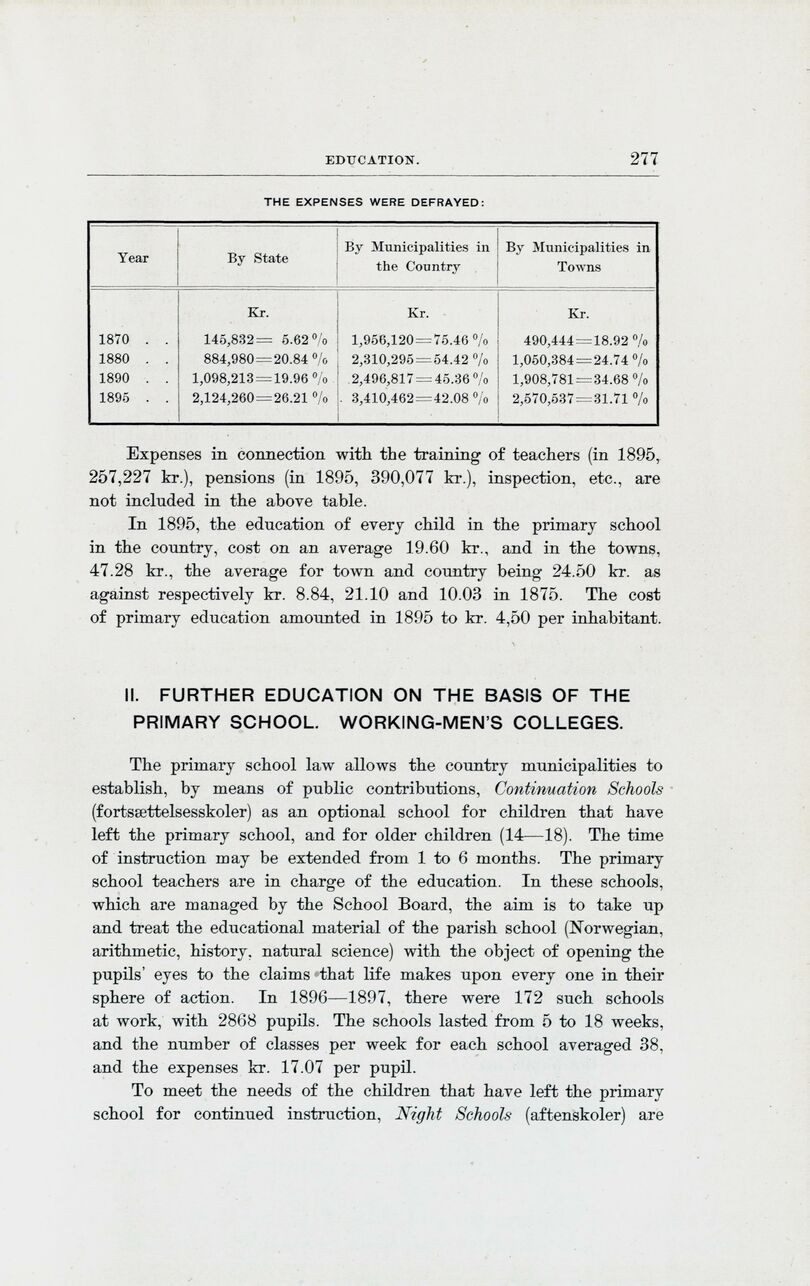
Full resolution (JPEG)
- On this page / på denna sida
- Education, by J. V. Heiberg

<< prev. page << föreg. sida << >> nästa sida >> next page >>
Below is the raw OCR text
from the above scanned image.
Do you see an error? Proofread the page now!
Här nedan syns maskintolkade texten från faksimilbilden ovan.
Ser du något fel? Korrekturläs sidan nu!
This page has been proofread at least once.
(diff)
(history)
Denna sida har korrekturlästs minst en gång.
(skillnad)
(historik)
THE EXPENSES WERE DEFRAYED:
| Year | By State | By Municipalities in the Country | By Municipalities in Towns |
| | Kr. | Kr. | Kr. |
| 1870 . . | 146,882 = 5.62 % | 1,956,120 = 75.46 % | 490,444 = 18.92 % |
| 1880 . . | 884,980 = 20.84 % | 2,310,295 = 54.42 % | 1,050,384 = 24.74% |
| 1890 . . | 1,098,213 = 19.96 % | 2,496,817 = 45.36 % | 1,908,781 = 34.68 % |
| 1895 . . | 2,124,260 = 26.21 % | 3,410,462 = 42.08 % | 2,570,537 = 31.71 % |
Expenses in connection with the training of teachers (in 1895,
257,227 kr.), pensions (in 1895, 390,077 kr.), inspection, etc., are
not included in the above table.
In 1895, the education of every child in the primary school
in the country, cost on an average 19.60 kr., and in the towns,
47.28 kr., the average for town and country being 24.50 kr. as
against respectively kr. 8.84, 21.10 and 10.03 in 1875. The cost
of primary education amounted in 1895 to kr. 4,50 per inhabitant.
II. FURTHER EDUCATION ON THE BASIS OF THE
PRIMARY SCHOOL. WORKING-MEN’S COLLEGES.
The primary school law allows the country municipalities to
establish, by means of public contributions, Continuation Schools
(fortsættelsesskoler) as an optional school for children that have
left the primary school, and for older children (14—18). The time
of instruction may be extended from 1 to 6 months. The primary
school teachers are in charge of the education. In these schools,
which are managed by the School Board, the aim is to take up
and treat the educational material of the parish school (Norwegian,
arithmetic, history, natural science) with the object of opening the
pupils’ eyes to the claims that life makes upon every one in their
sphere of action. In 1896—1897, there were 172 such schools
at work, with 2868 pupils. The schools lasted from 5 to 18 weeks,
and the number of classes per week for each school averaged 38,
and the expenses kr. 17.07 per pupil.
To meet the needs of the children that have left the primary
school for continued instruction, Night Schools (aftenskoler) are
<< prev. page << föreg. sida << >> nästa sida >> next page >>
Project Runeberg, Sun Dec 10 21:09:24 2023
(aronsson)
(diff)
(history)
(download)
<< Previous
Next >>
https://runeberg.org/norparis/0289.html



